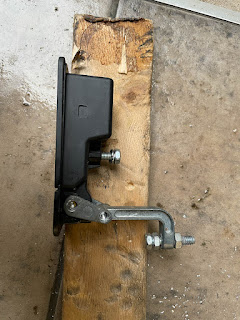We bought this 20 year old RV earlier this year. One item to repair were the cargo latches on the flip-up door next to the bunk beds. The spring action in the latch was weak - so when you depress the release tab, the lever would not spring up to open the latch. You would have to reach under the level with a fingernail and try to pop it up. In addition, the latch seals were completely rotten, allowing water to get into the door can causing the start of some black mould and rusty hardware.
 |
| Starting point - seal half gone, weathered latch body |
Some exhausting internet research and I managed to find the same latch for sale on an Asian e-commerce site, however, the inside lever which holds the latch closed did not match my latches. I couldn't find an exact match anywhere, so I decided to order the similar latch and attempt to swap the inside levers from my old latches to the new latch body with new springs and lock cylinders.
 |
| New latch with the shorter inner level. Drilling out the rivets holding the inner lever on the latch. |
A few weeks later the new latches arrive, and luckily, they are physically similar. I start by disassembling the inner lever on one of the new latches by drilling out the rivets. The rivets are actually part of the inner lever casting - so when I did the same on the old latches I was very careful to remove a minimum amount of material with a twist drill to facilitate reassembly.
 |
| With the rivets drilled out, the inner lever pulls apart from side to side. |
It was then straightforward to transfer the inner levers from the old latch onto the new latch with new springs. The dimensions were all accurate, the o-ring seal which keeps water out of the latch mechanism was transferred off the old inner lever to the new inner lever and everything went back together with some gentle tapping and plier pressure.
 |
| Old latch and inner lever - rivets drilled out and separating the two halves |
 |
| Reassembling the old inner lever on the new latch - the wood protects the finish on the latch when tapping. |
With the inner levers swapped, it was simple to reinstall the latches in the cargo door with the new seals provided with the latches:
 |
| New latch installed with new seals |
Here's a photo of the old seal next to the new seal - this was the better of the two old seals - the other seal had completely disintegrated.
 |
| New and old latch seals |
Finally - I reached out to the latch vendor, and ordered some spare sets of seals if you just want to replace your seals. Just click on this link to take you to the sales page on eBay.





















